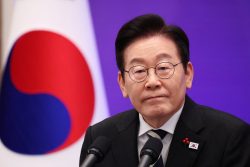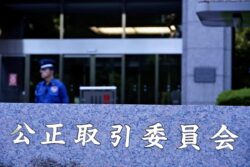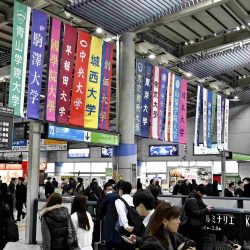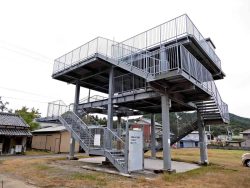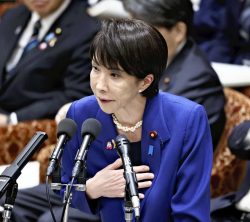Kishida Uses on Factions to Deal With Faction-Linked Crisis; PM Seeks to Keep Aso, Motegi and Moriyama on His Side
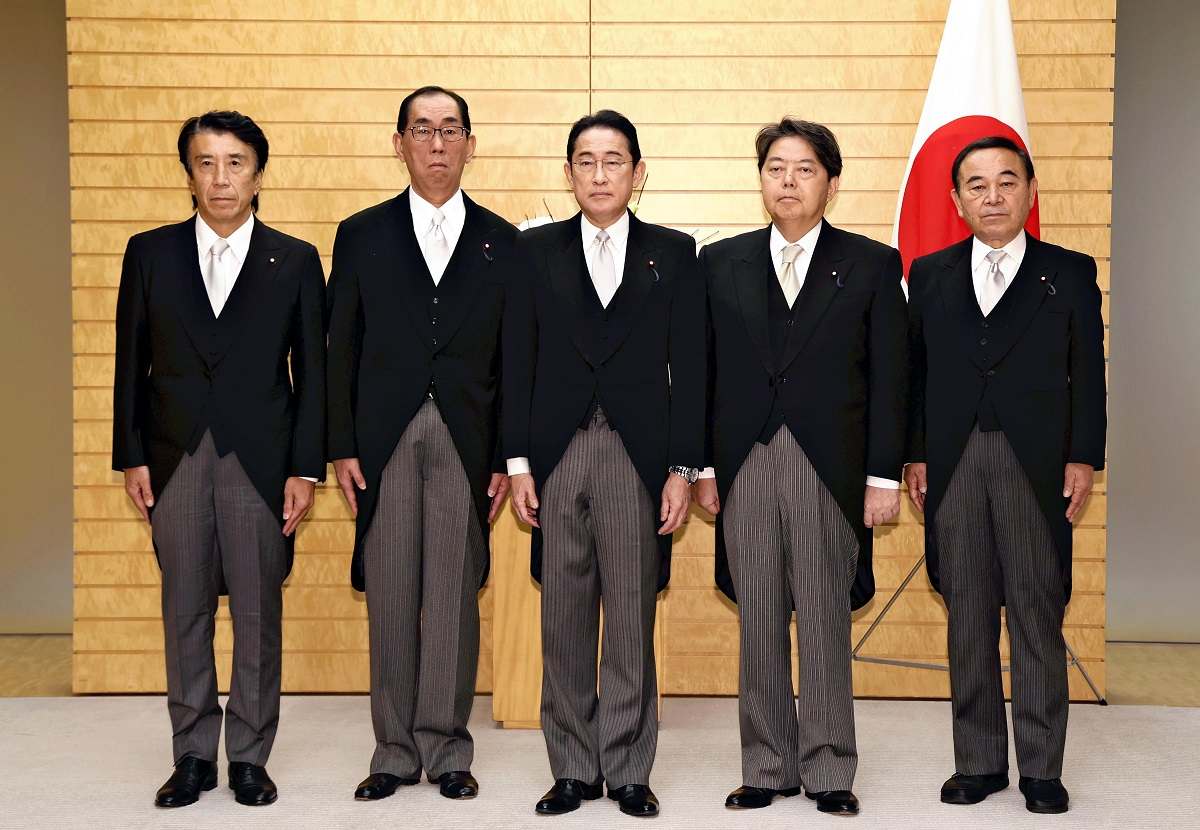
Posing for a commemorative photo are, from left, new Economy, Trade and Industry Minister Ken Saito; new Internal Affairs and Communications Minister Takeaki Matsumoto; Prime Minister Fumio Kishida; new Chief Cabinet Secretary Yoshimasa Hayashi; and new Agriculture, Forestry and Fisheries Minister Tetsushi Sakamoto.
18:30 JST, December 15, 2023
When Prime Minister and ruling Liberal Democratic Party President Fumio Kishida recently replaced four Cabinet ministers including the chief cabinet secretary, he showed consideration to party faction leaders such as LDP Vice President Taro Aso. This clearly suggests that Kishida will continue to depend on cooperation from LDP factions under the new lineup, even though it has no members from the Abe faction. Kishida’s leadership has been deteriorating, casting a shadow over his strategy for dissolution of the House of Representatives.
Tug-of-war
“I was able to implement the personnel changes as planned, including the new leadership lineup,” Kishida told reporters Thursday about the replacement of Cabinet ministers after attending an attestation ceremony for newly appointed Cabinet ministers including Chief Cabinet Secretary Yoshimasa Hayashi.
In the latest personnel changes conducted in response to allegations that some members of the Abe faction received off-the-books kickbacks from political fundraising party revenue, Kishida found it most difficult to find a successor to the chief cabinet secretary, the key position in the Cabinet, because there were only a limited number of competent lawmakers who have experience as Cabinet ministers and also appear to have nothing to do with the allegations.
There was the behind-the-scenes tug-of-war within the government.
According to aides close to the prime minister, Kishida thought that he had no choice but to depend on Hayashi. However, Aso showed reluctance to the idea of appointing Hayashi as the new chief cabinet secretary because Hayashi had not gotten along with the late former Prime Minister Shinzo Abe, who had been Aso’s close ally, in Yamaguchi Prefecture where Hayashi’s and Abe’s constituencies were located. Aso instead recommended former Defense Minister Yasukazu Hamada, who is affiliated with no faction but is close to Aso, for the position.
Seiji Kihara, Kishida’s close aide and acting LDP secretary general, tried to learn Hamada’s thinking about it on Tuesday, although Kihara doubted Hamada would accept the offer because he did not like to stand out at press conferences and on other occasions, which is part of a chief cabinet secretary’s job.
“I am happy to fully support the government, but I cannot be chief cabinet secretary. I can accept the position of chairperson of the party’s Diet Affairs Committee as I have served in that position before,” Hamada reportedly told Kihara.
This response narrowed down Kishida’s choice for the next chief cabinet secretary to Hayashi.
To save face for Aso, Kishida appointed Takeaki Matsumoto from the Aso faction as the new internal affairs minister. Some recommended Ken Saito, who does not belong to any faction, to be chief cabinet secretary. However, given that Saito was a former bureaucrat in the economy ministry, Kishida appointed him as the new economy, trade and industry minister.
For agriculture minister, Kishida picked Tetsushi Sakamoto from the Moriyama faction, out of consideration for faction leader Hiroshi Moriyama, who is the LDP’s General Council chair and represents the interests of the agriculture and forestry industry.
Skepticism
Kishida had earlier appointed Hirokazu Matsuno and Yasutoshi Nishimura, both from the Abe faction — the largest faction in the LDP — to key ministerial positions to achieve the stable management of the government. After sacking the Abe faction members, Kishida is apparently trying to strengthen cooperation with the Aso faction, the Moriyama faction and the Motegi faction, led by LDP Secretary General Toshimitsu Motegi, all of which are less affected by the kickback allegations.
Even amid growing criticism of faction-oriented politics, Kishida did not move away from that style because his leadership within the LDP is rapidly deteriorating due to the recent allegations emerging at a time when approval of his Cabinet was already declining
While Kishida replaced many ministers, he did not call it a “Cabinet reshuffle” but rather a “replacement of officials who resigned” because he believed it would be “risky” to have a reshuffle in which all Cabinet ministers submit their resignations. “There was a skeptical view that, if some Cabinet ministers had thought the government was on its last legs and refused to be reappointed, it would have thrown Kishida’s government into chaos,” a senior government official said.
Misstep
A misstep for Kishida was that a plan to replace all 15 Abe faction members in the top three levels of ministry positions — minister, state minister and parliamentary vice minister — caused the Abe faction to take a hardline stance. While the plan was considered within the LDP at one point, Kishida was careful about it, saying to his aides that there would not be such an easy solution. However, as the plan was reported by media outlets and others and became widely known, a middle-ranking lawmaker in the Abe faction fiercely opposed the plan saying, “This is the beginning of our battle against Kishida.”
“I considered the intention and situation of each individual lawmaker, not the political groups they belong to,” Kishida told reporters Thursday, talking about his decision to retain five Abe faction members in their current parliamentary vice minister positions. This suggests that he wants to avoid a decisive confrontation with the Abe faction.
"Politics" POPULAR ARTICLE
-

Japan to Support Central Asian Logistics Route That Bypasses Russia, Plan to Be Part of Upcoming Summit in Tokyo
-

Japan to Tighten Screening of Foreigners’ Residential Status by Providing Information of Nonpayment of Taxes
-

Chinese, Russian Bombers Flew Unusual Path by Heading Toward Tokyo; Move Likely Meant to Intimidate Japan
-
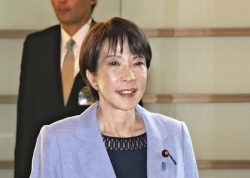
Japan Plans National Database to Track Foreign Ownership of Real Estate, Land as It Weighs New Rules
-

Up to 199,000 Deaths Estimated From Mega-Tsunami; Most Recent Occurrence Took Place in 17th Century
JN ACCESS RANKING
-

Tokyo Economic Security Forum to Hold Inaugural Meeting Amid Tense Global Environment
-

Keidanren Chairman Yoshinobu Tsutsui Visits Kashiwazaki-Kariwa Nuclear Power Plant; Inspects New Emergency Safety System
-

Imports of Rare Earths from China Facing Delays, May Be Caused by Deterioration of Japan-China Relations
-

University of Tokyo Professor Discusses Japanese Economic Security in Interview Ahead of Forum
-

Japan Pulls out of Vietnam Nuclear Project, Complicating Hanoi’s Power Plans



-250x167.jpg)
